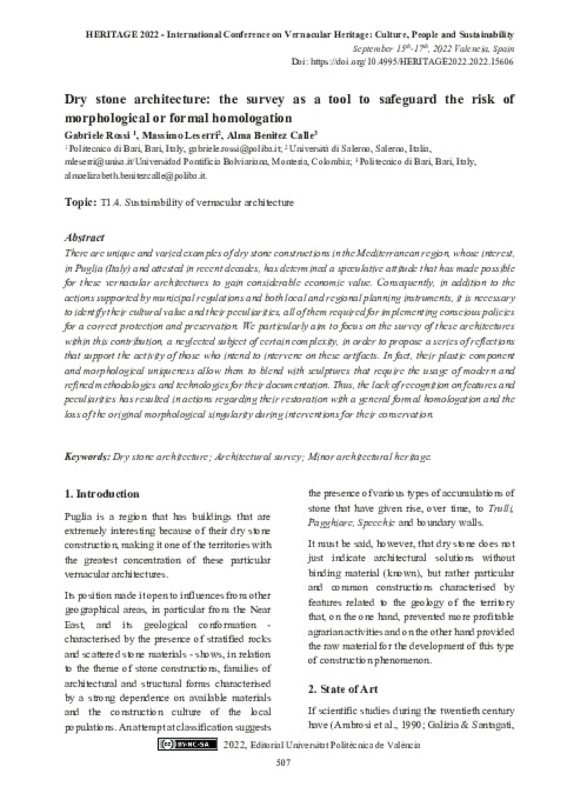JavaScript is disabled for your browser. Some features of this site may not work without it.
Buscar en RiuNet
Listar
Mi cuenta
Estadísticas
Ayuda RiuNet
Admin. UPV
Dry stone architecture: the survey as a tool to safeguard the risk of morphological or formal homologation
Mostrar el registro sencillo del ítem
Ficheros en el ítem
| dc.contributor.author | Rossi, Gabriele
|
es_ES |
| dc.contributor.author | Leserri, Massimo
|
es_ES |
| dc.contributor.author | Benitez Calle, Alma
|
es_ES |
| dc.date.accessioned | 2022-11-02T08:54:41Z | |
| dc.date.available | 2022-11-02T08:54:41Z | |
| dc.date.issued | 2022-09-13 | |
| dc.identifier.isbn | 9788413960203 | |
| dc.identifier.uri | http://hdl.handle.net/10251/188975 | |
| dc.description.abstract | [EN] There are unique and varied examples of dry stone constructions in the Mediterranean region, whose interest, in Puglia (Italy) and attested in recent decades, has determined a speculative attitude that has made possible for these vernacular architectures to gain considerable economic value. Consequently, in addition to the actions supported by municipal regulations and both local and regional planning instruments, it is necessary to identify their cultural value and their peculiarities, all of them required for implementing conscious policies for a correct protection and preservation. We particularly aim to focus on the survey of these architectures within this contribution, a neglected subject of certain complexity, in order to propose a series of reflections that support the activity of those who intend to intervene on these artifacts. In fact, their plastic component and morphological uniqueness allow them to blend with sculptures that require the usage of modern and refined methodologies and technologies for their documentation. Thus, the lack of recognition on features and peculiarities has resulted in actions regarding their restoration with a general formal homologation and the loss of the original morphological singularity during interventions for their conservation. | es_ES |
| dc.description.abstract | [IT] Ci sono esempi unici e variegati di costruzioni in pietra a secco nella regione mediterranea, il cui interesse, in Puglia (Italia) e attestato negli ultimi decenni, ha determinato un atteggiamento speculativo che ha permesso a queste architetture vernacolari di acquisire un notevole valore economico. Di conseguenza, oltre alle azioni supportate dai regolamenti comunali e dagli strumenti di pianificazione sia locale che regionale, è necessario individuarne il valore culturale e le peculiarità, tutte necessarie per attuare politiche consapevoli per una corretta tutela e conservazione. Ci proponiamo in particolare di concentrarci sul rilievo di queste architetture all'interno di questo contributo, un argomento trascurato di una certa complessità, al fine di proporre una serie di riflessioni che supportino l'attività di coloro che intendono intervenire su questi manufatti. Infatti, la loro componente plastica e l'unicità morfologica permettono loro di fondersi con sculture che richiedono l'utilizzo di metodologie e tecnologie moderne e raffinate per la loro documentazione. Pertanto, il mancato riconoscimento su caratteristiche e peculiarità ha portato ad azioni riguardanti il loro restauro con un'omologazione formale generale e la perdita della singolarità morfologica originale durante gli interventi per la loro conservazione. | es_ES |
| dc.format.extent | 6 | es_ES |
| dc.language | Inglés | es_ES |
| dc.publisher | Editorial Universitat Politècnica de València | es_ES |
| dc.relation.ispartof | Proceedings HERITAGE 2022 - International Conference on Vernacular Heritage: Culture, People and Sustainability | |
| dc.rights | Reconocimiento - No comercial - Compartir igual (by-nc-sa) | es_ES |
| dc.title | Dry stone architecture: the survey as a tool to safeguard the risk of morphological or formal homologation | es_ES |
| dc.type | Capítulo de libro | es_ES |
| dc.type | Comunicación en congreso | es_ES |
| dc.identifier.doi | 10.4995/HERITAGE2022.2022.15606 | |
| dc.rights.accessRights | Abierto | es_ES |
| dc.description.bibliographicCitation | Rossi, G.; Leserri, M.; Benitez Calle, A. (2022). Dry stone architecture: the survey as a tool to safeguard the risk of morphological or formal homologation. En Proceedings HERITAGE 2022 - International Conference on Vernacular Heritage: Culture, People and Sustainability. Editorial Universitat Politècnica de València. 507-512. https://doi.org/10.4995/HERITAGE2022.2022.15606 | es_ES |
| dc.description.accrualMethod | OCS | es_ES |
| dc.relation.conferencename | HERITAGE2022 International Conference on Vernacular Heritage: Culture, People and Sustainability | es_ES |
| dc.relation.conferencedate | Septiembre 15-17, 2022 | es_ES |
| dc.relation.conferenceplace | Valencia, España | es_ES |
| dc.relation.publisherversion | http://ocs.editorial.upv.es/index.php/HERITAGE/HERITAGE2022/paper/view/15606 | es_ES |
| dc.description.upvformatpinicio | 507 | es_ES |
| dc.description.upvformatpfin | 512 | es_ES |
| dc.type.version | info:eu-repo/semantics/publishedVersion | es_ES |
| dc.relation.pasarela | OCS\15606 | es_ES |








